
In the 1960s, Kern-Paillard began manufacturing a line of zoom lenses for Bolex cameras. Innovations in lens design produced the first automatic exposure zoom lens for 16mm motion picture cameras; the Vario Switar 36EE.
With the introduction of the Bolex H-8 REX camera, a new line of lenses was designed. The H-8 REX adopted a turret that used the same 1" diameter thread of C mount lenses, but with an optical distance between lens seat and film plane of 15.305mm. This outfit of three prime lenses is listed below. Two zoom lenses were also designed specifically for the H-8 REX: the Vario Switar 36 and 36EE.
Another significant development was the introduction of macro lenses for H-8 and H-16 reflex cameras. These lenses featured a built-in macro extension with pre-set diaphragms. Listed below are the lenses manufactured by Kern-Paillard during the 1960s.
Lenses for H-8 Reflex Cameras
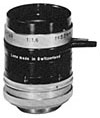 Switar 5.5mm f/1.6 H8 rx
Switar 5.5mm f/1.6 H8 rx
Wide angle lens, specifically designed for the H-8 REX camera. It featured
a pre-set diaphragm, Visifocus depth of field scale and minimum focusing distance
of 4 1/2 inches. Series V filters could be attached.
 Macro Switar 12.5 f/1.3 H8 rx
Macro Switar 12.5 f/1.3 H8 rx
Standard focal length lens for the H-8 REX; pre-set diaphragm with Visifocus
DOF scale and built in macro extension. Focus from 3" to infinity. Uses Series
V filters; detachable lens hood.
 Macro Switar 36mm f/1.4 H8 rx
Macro Switar 36mm f/1.4 H8 rx
Telephoto lens for the H-8 REX; pre-set diaphragm with Visifocus DOF scale
and built in macro extension. Focus from 10 1/2" to infinity. Uses Series
V filters; detachable lens hood.
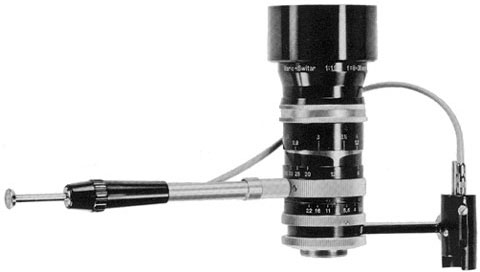 Vario Switar 36 f/1.9 (8mm-36mm)
Vario Switar 36 f/1.9 (8mm-36mm)
Introduced in 1962 and designed by Kern for the H-8 reflex. It incorporated
an automatic pre-set diaphragm feature which opened the diaphragm for viewing
and focusing and closed it automatically prior to exposure. The pre-set aperture
control and camera release mechanism were combined with a zoom lever; this
could be couple to the Declic H grip with a special accessory cable (not shown).
It could accept Series VI filters and weighed 13.5 ounces.
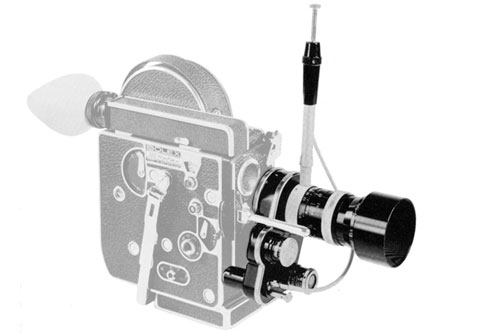 Vario Switar 36EE (8mm-36mm f/1.9)
Vario Switar 36EE (8mm-36mm f/1.9)
The Vario Switar 36EE ("Electric Eye") was introduced in 1964. It featured
a fully automatic diaphragm control with a cadmium sulphide photo resistor
which was sensitive to film ratings from 10-400 ASA. The exposure meter was
powered by one (1) PX-13 1.35v mercury cell battery.
The lens could be fitted with Series VI filters and weighed 18 ounces.
C and RX Mount Lenses for H-16 Cameras
 Switar 10mm f/1.6 RX
Switar 10mm f/1.6 RX
Wide angle lens with pre-set diaphragm, vVisifocus depth of field scale and
minimum focus distance of 1". Introduced in 1968 for use with H-16 reflex
cameras.
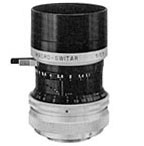 Macro Switar 26mm f/1.1 RX
Macro Switar 26mm f/1.1 RX
Standard focal length lens with built in macro extension, pre set diaphragm,
Visifocus DOF scale and minimum focus distance of 7 1/2". Introduced in 1968
for use with H-16 reflex cameras.
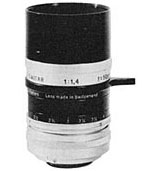 Macro Switar 50mm f/1.4 Rx
Macro Switar 50mm f/1.4 Rx
Telephoto lens for H-16 reflex cameras, introduced in 1964. Pre set diaphragm,
Visifocus DOF scale, built in macro extension and minimum focus distance of
15".
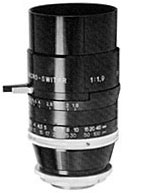 Macro-Switar 75mm f/1.9
Macro-Switar 75mm f/1.9
C mount Telephoto lens, introduced in 1970. Pre set diaphragm, Visifocus DOF
scale, built in macro extension and minimum focus distance of 5 feet.
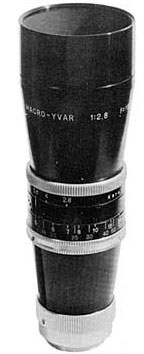 Macro Yvar 100mm f/2.8
Macro Yvar 100mm f/2.8
Introduced in 1963; C mount telephoto lens with Visifocus depth of field scale
and built in macro extension. Minimum focus distance of 4 feet. Accepts Series
VI drop in filters.
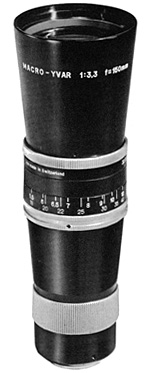 Macro Yvar 150mm f/3.3
Macro Yvar 150mm f/3.3
Introduced in 1962; C mount, extreme telephoto lens with Visifocus DOF scale
and built in macro extension. Minimum focus distance of 6 feet; minimum aperture
of f/32. Accepts Series VI drop in filters.
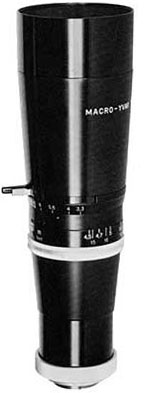 Macro Yvar 150mm f/3.3
Macro Yvar 150mm f/3.3
The Macro Yvar 150mm was redesigned in 1970 to include a pre-set diaphragm.
It also featured Visifocus DOF scale and built in macro extension. Minimum
focus distance: 6 feet. Minimum diaphragm setting: f/32. Accepts Series VI
drop in filters.
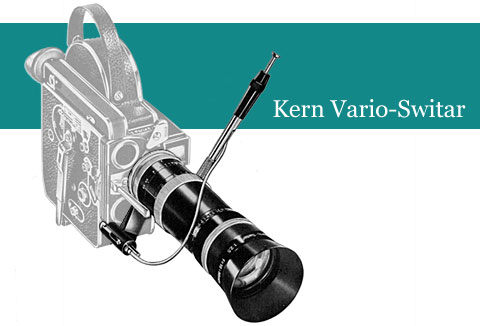 Vario Switar 86
Vario Switar 86
Introduced in 1961; designed specifically for H-16 reflex cameras. It incorporated
an automatic pre-set diaphragm feature which opened the diaphragm for viewing
and focusing and closed it automatically prior to exposure. The pre-set aperture
control and camera release mechanism were combined with a zoom lever; this
could be couple to the Declic H grip with a special accessory cable (not shown).
Zoom range from 18-86mm; maximum aperture f/2.5, minimum aperture f/22. The
lens could accept Series VIII filters and weighed 2 lbs and 4 oz.
 Vario Switar 86EE (18mm-86mm f/2.5)
Vario Switar 86EE (18mm-86mm f/2.5)
This lens was introduced in 1964, as the first "Electric Eye" 16mm zoom lens.
It was designed specifically for H-16 reflex cameras and featured a fully
automatic diaphragm control with a cadmium sulphide photo resistor which was
sensitive to film ratings from 10-400 ASA. The exposure meter was powered
by one (1) PX-13 1.35v mercury cell battery.
Minimum aperture of f/16. Weight: 2 lbs, 4 oz. Accepts Series VIII filters.
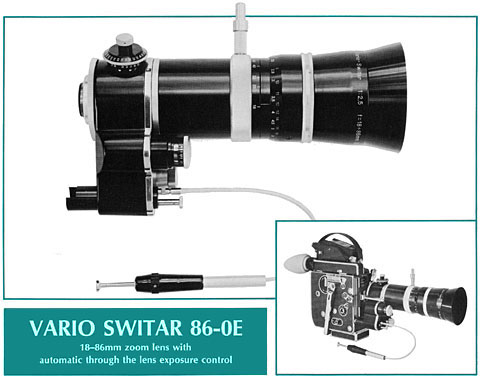 Vario-Switar 86-OE (18mm-86mm f/2.5)
Vario-Switar 86-OE (18mm-86mm f/2.5)
The 86-OE was introduced in 1968. It featured an automatic diaphragm, but
unlike the 86EE, exposure measurements were taken through the lens. The built
in meter was sensitive to film speeds from 10 to 200 ASA and powered by one
(1) PX-13 1.35v mercury cell battery. Minimum
aperture: f/16. Weight: approximately 2 1/2 lbs. Accepts Series VIII filters.
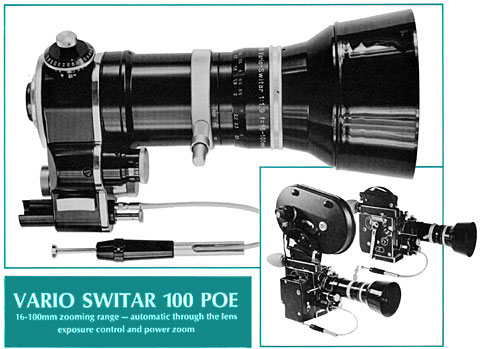 Vario Switar 100 POE (f/1.9 16-100mm)
Vario Switar 100 POE (f/1.9 16-100mm)
Introduced in 1970, the Kern Vario Switar 100 POE featured through the lens
exposure and power zoom control. The exposure meter was powered by one (1)
PX1 1.35v mercury cell battery; power for the zoom motor was supplied by two
(2) RM1 1.35V mercury batteries batteries. It accepts series IX filters and
weighs approximately 3 lbs.
Although the 100 POE is a nice lens, unfortunately there is no exact equivalent for a PX1 battery that will provide an accurate exposure reading; at least not without a voltage reducing adapter. The diaphragm can be adjusted manually, however; a more accurate exposure reading is best obtained with a hand held exposure meter.